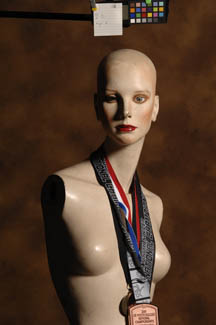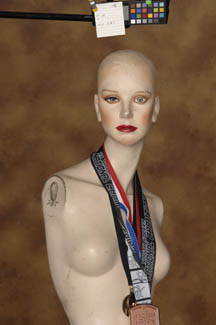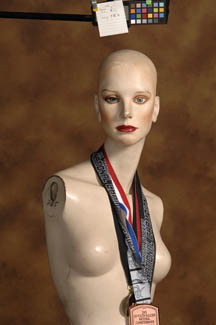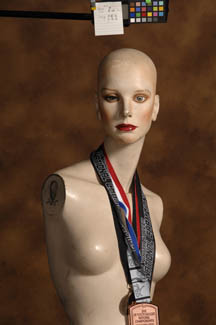|
Portrait Photography Lighting - Light ratios using photographic lighting equipment
Whenever photographers discuss portrait lighting or begin learning about portrait lighting, one of the first subjects discussed is the subject of lighting ratios. What follows is an explanation of light ratios, along with samples to illustrate the ideas discussed. A quality portrait photographer needs to understand the principles and the use of his photographic lighting equipment to produce the best possible photographic images for himself and his portrait client.
|
|
|
Main Light in portrait photography lighting
In the beginning, God made the sun. And ever since then, we photographers have been trying to duplicate it. One of the main characteristics of the sun is that there is only one of them. Hence, we humans usually prefer to see everything lit by only one light source. How can we usually tell how many light sources there are? By the shadows, silly. One shadow means one light source. One light source, life is good (subconsciously anyway).
Light Ratios in portrait photography lighting
Shortly after God made the sun, he realized that the light ratio was going to be much too high for us photographers. So in his infinite wisdom, he made the sky so that some of that sunshine would bounce around the clouds and atmospheric haze, thus “filling in” the harsh shadows, and therefore relieving the high contrast of our portraits.
|
|
| Main |
Fill |
Ratio |
|
Sample |
|
1 (f-11)
|
0
|
|
Portrait photography lighting ratio 1 : 0
All lights create some shadow. Here is an example of a 1 to 0 light ratio. Ok, it is and it isn’t. In reality, even if you have no other light source being used as a fill light, you will have light bouncing around the environment FROM the main light, acting as a fill. Depending on the environment, that ambient light can be substantial. For example… If your studio is a small white room, the ambient fill light may cause you to have trouble getting the shadows as dark as you would like, even if you don’t use a “fill light”. The white walls may act as your fill.
|
 |
|
0
|
|
0 : 1
|
Portrait photography lighting ratio 0 : 1
This is a sample of just fill light. Notice how there are no shadows. I guess that you would actually consider this shadowless light to be the main light. I just wanted to show you the perfect fill light.
|
 |
|
|
|
2 : 1
|
Portrait photography lighting ratio 2 : 1
A “fill” light, when used properly, cast as little shadow as possible. Its primary purpose is to lighten he shadows. Here we have an example of a fill light being the same intensity as the main light. Note that you can still see a shadow from the main light. The side of the face being lit by the mail light (1) is ALSO being lit by the fill light (1). So the lit side of the face is being lit by both lights (1+1=2) The shadow area is being lit only by the fill light (1), so the light ratio is said to be 2 to 1 (lit to shadow) It’s that simple.
(look at the front of the body vs. the side of the body - it's a little more noticeable)
|
 |
|
|
|
3 : 1
|
Portrait photography lighting ratio 3 : 1
So what happens if you decrease the intensity of the fill light by one half. That would make the main light twice (2) as bright as the fill light (1). The shadow side of the face gets lit only by the fill light while the lit side of the face gets lit by both the fill light (1) + the main light (2) making the ratio (1+2) 3 : 1. Get it?
|
 |
|
|
|
5 : 1
|
Portrait photography lighting ratio 5 : 1
If you half the fill light again (1/4), you’re essentially making the main light 4 times as bright as the fill light you just decreased in power. The ratio would be (4+1) 5: 1
|
 |
|
|
|
9 : 1
|
Portrait photography lighting ratio 9 : 1
You get the idea…
|
 |
|
|
So what’s the best light ratio? There is no such thing. Photography is an art! There are times when you should use high light rations and there are times when a low light ration is more appropriate. The choice is yours.
© Michael Ray 2010
|
|
|
|
|
|
|
|
|
|
Michael Ray's photography and advertising links
|
|
|
|
|
|
|
|
|
|
|
|
|
|
|
|
|
|
|
|
|
|
|
|
|
|
|